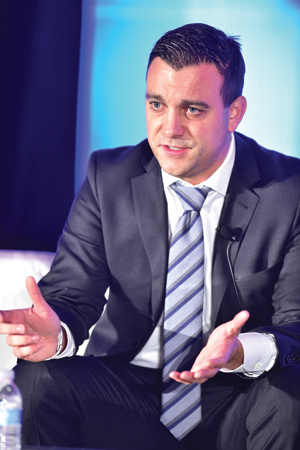
W hen we bought our soccer team, Sporting Kansas City, we had no fans. We had 389 season tickets.
You make these big investments as an owner and all the systems within a stadium, whether it’s ticketing, access control, points of sale, social feeds, Wi-Fi data, everything like that. We said, “Why wouldn’t we try to figure out a way similar to what we had done in health care with sports, and bring all that information into a single profile.”
 |
Photo by: MARC BRYAN-BROWN
|
We started to use Sporting Park, our stadium, as really kind of a living lab to try this out.
At Sporting Park … we’ve got 17 different systems that connect into the Fan360 platform, and we’ve got about 380,000 Sporting fans that on average we know about 62 different attributes of information on them. So, not only who and what they are but what brand propensities they may have, who they come with to games, what time they get there.
I’m a ticket sales kid at Sporting Kansas City and I’m making a call [and] I’ve got right in front of [me] quick information on who you are, what section you buy in and when you come, but I also may have the favorite player that you tweet about.
We went from 389 season tickets to … 14,000 season tickets, we’ve got an 11,000-person waiting list and we’ve sold out 52 matches in a row. We just did renewals for season tickets for next year, which we renewed at 98 percent, so, yeah, I mean, it’s changed a lot.
For colleges, it’s really, How can I impact not only the stadium experience but college life in general? Obviously the donor data is a whole segment that’s completely different from the sports space. And so it’s, How can we generate data not only for the athletic department but maybe for development as well?
The problems that we’re trying to solve are well-documented: ticket sales, getting students to come, getting students to stay. So those are the sorts of things and tactics that we’re trying to work around, so it’s, Do you build a rewards campaign? Is there a loyalty campaign?
A very valuable nuance that you can generate in sports is, if you can get somebody to feel as though they’re part of the brand as opposed to a fan of the brand, the ability for you to activate and ask them to do things goes up exponentially.
In our venue, [a] 20,000-seat soccer stadium, we typically have about 13,000 people on [Wi-Fi] concurrently.
College, it’s much higher than it is in the pros. … Pro typically skews older, there’s less engagement with a mobile app in a lot of the pro venues that we deal with.
There are a lot of college venues that are doing a very good job with Wi-Fi, but as far as the percentage of venues that have high-density Wi-Fi, it’s still less in college.
We basically create a master person index of all the different attributes that are in your system and that then allows you to build segmentations against that, so if I want to pick — you’re a woman, you’re between 20 and 27, and you have a brand propensity towards insurance — that’s a segmentation you should be able to build, and we can give you the sort pretty quickly up against your data.
There’s lots of data, but you can drive lots of really valuable use cases just probably out of six to 12 very obvious touch points that we all have in our venue. We just haven’t had a really good way to collect them, bring them in and do anything meaningful with them.

For the first time really, a sponsor can sit there and know in real time if they’ve got their customers in the venue. They can sort of downgrade what they need around fixed signage.
The other thing that we deal with in the colleges is the commingling of athletic data or athletic department data and donor data. We have huge, long negotiations with most all of our college clients around how that’s going to be dealt with.
The cool thing about Europe is they’ve got much higher mobile penetration in a lot of their stadiums from a smartphone perspective. If you’re in Norway, 90 percent of the phones that walk into a stadium are smartphones; in the U.S. it’s still closer to about 58 to 60 percent.
The World Cup was good this year, and we had two players that played in the World Cup, Graham Zusi and Matt Besler, and the U.S. responded really well to it, but our team’s got to get better.
As cool as Major League Soccer is, the most important thing that could happen in U.S. soccer as an owner in Major League Soccer is for the U.S. to win the World Cup.
Soccer is a big thing. It’s been one of those things that obviously for 30 years, or whatever the time is, everybody has said, “Well, it’s coming, when’s it coming?” I feel like it’s here.






